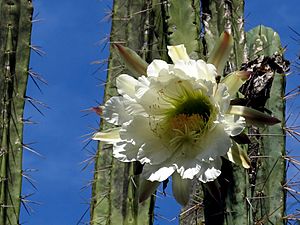Peruvian torch cactus facts for kids
Quick facts for kids Peruvian torch cactus |
|
|---|---|
 |
|
| A Peruvian torch cactus in bloom | |
| Scientific classification | |
| Genus: |
Echinopsis
|
| Species: |
peruviana
|
| Synonyms | |
|
Trichocereus peruvianus Britton & Rose |
|
The Peruvian torch cactus, also known as Echinopsis peruviana (or Trichocereus peruvianus), is a type of tall, column-shaped cactus. It grows quickly and is found naturally on the western side of the Andes mountains in Peru. These cacti live at high altitudes, usually between 2,000 and 3,000 meters (about 6,500 to 9,800 feet) above sea level.
What it Looks Like
This cactus has a bluish-green color and stems that look a bit frosted. Its stems have 6 to 9 rounded ridges, which are called ribs. When it blooms, it produces large, white flowers.
The Peruvian torch cactus can grow quite tall, reaching heights of 3 to 6 meters (about 10 to 20 feet). Its stems can be 8 to 18 centimeters (about 3 to 7 inches) wide. When it's young, it stands straight up. As it gets older, it might start to lean, arch over, or even lie flat on the ground.
Along its ribs, the cactus has groups of 6 to 8 stiff spines. These spines are honey-colored to brown and can be up to 4 centimeters (about 1.5 inches) long, though most are about 1 centimeter (0.4 inches). These spine groups are spaced out evenly, about 2.5 centimeters (1 inch) apart, along the ribs.
Different Types of Peruvian Torch Cactus
Just like there are different types of apples, there are also different types of Peruvian torch cacti. Scientists group living things into categories. The main type is called a "species," and sometimes there are smaller groups within a species called "subspecies" or "varieties."
Some of these varieties are named after the places where they are found in Peru, like:
- var. ancash from San Marcos, Ancash
- var. ayacuchensis from southwestern Peru
- var. cuzcoensis from Huachac, Cuzco
- var. matucana from Lima
- var. puquiensis from Puquio, Apurímac Region
Images for kids
See also
 In Spanish: Echinopsis peruviana para niños
In Spanish: Echinopsis peruviana para niños




